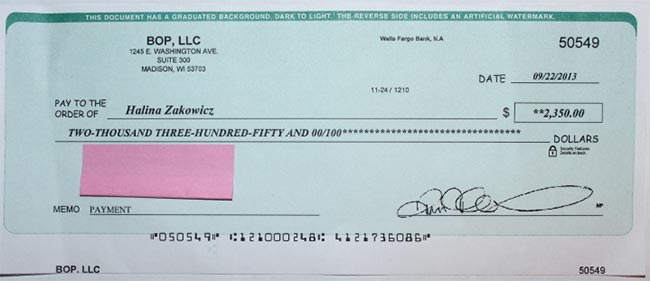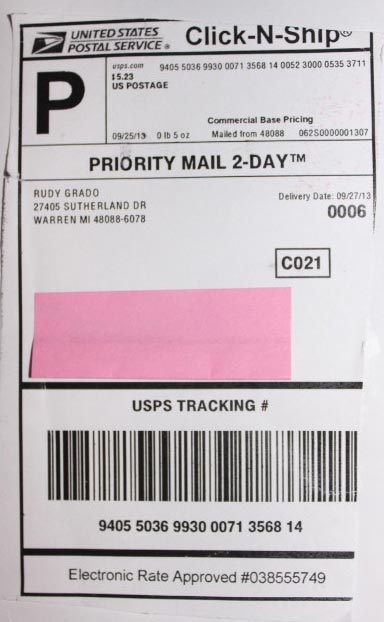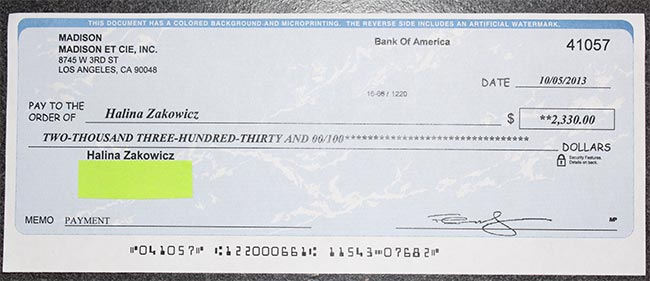In a nutshell: car wrap scams are a type of fake check scams.
I first wrote about this scam back in 2013 and it’s almost 10 years later and still going strong.
This post alone has over 1,000 comments from people I’ve helped and countless more have written to me privately. I’ve saved tens of millions of dollars from falling into scammers hands.
If you aren’t careful, it can cost you thousands of dollars.
In fact, a study by the FTC showed that people reported a median loss of $1,988 in 2019 to fake check scams, including car wrap scams (Source)
Today, I’ll explain what a car wrap scam is, how to spot one, and relay my own personal experience with this scam, complete with photos.
How Do Car Wrap Scams Work?
As I’ve mentioned, car wrap scams are a type of fake check scams.
Generally, here’s how a fake check scam works:
1. Scammers get in contact with you.
Scammers get your information while you’re looking for a legitimate work from home job and reach out with a job offer.
Or maybe you end up contacting them because you saw an ad to “get paid to drive,” “mystery shopper wanted,” or “virtual assistant wanted.”
Others tell you that you’ve won a sweepstakes, even though you don’t remember ever buying a ticket or entering a contest.
2. They send you a fake check.
Once the scammer is talking to you, they send you a genuine-looking check. These checks look genuine enough to fool you and bank tellers.
Car wrap scammers will send you a check for a greater amount than they agreed to pay you. They’ll then tell you to deposit the check and send the graphic designers or car wrap service the rest of the amount so they can come and wrap your car.
Mystery shopping scammers will assign you to evaluate the services of a money transfer service or money order retailers, and sometimes gift card retailers. They’ll then send you a check to deposit it in your personal account and then wire the money to someone else or buy gift cards in that amount and send the codes to them.
Virtual or personal assistant scammers send you a check and then instruct you to buy gift cards for supplies for your clients and then send them the codes.
Sweepstakes scammers send you a huge check and then instruct you to wire them a certain percentage for taxes, handling fees, or processing fees.
3. You deposit the fake check.
When you make a check deposit, banks are legally required to make the funds available for you to withdraw immediately.
So you withdraw the funds and send the money to someone else or buy the gift cards, etc.
It all seems fuss-free and above board, right?
Wrong.
4. The check bounces.
It can take days or even weeks to uncover a fake check.
Once it’s uncovered, the check bounces and the bank takes back the money from your account.
But you’ve already sent thousands of your own dollars to the criminals!
And they’ve vanished by this time. No way to contact them, no way to get the gift card codes back.
So you’re on the hook for the money, and now you have to explain to your bank why you even deposited a fake check into your account in the first place. You’re out the overdraft fees as well if you don’t have enough to cover the money that the bank took back.
This post was originally published in 2013. This scam is STILL occurring today and it looks like it will continue well into the future.
In fact, car wrap scams are now even more dangerous as the people behind them are coming up with more convincing ways to trick people into losing their hard-earned money.
For instance, some of the brands they claim to work with include ROCKSTAR Energy Drink®, Monster Energy Drink, Aquafina, Pirelli Tyres, McCafe, Dunkin’ Donuts, Langers Juice Company, Dr. Pepper, Marlboro, Purell, and many other big names.
Keep reading to see my experience with this scam and if you have received an email that you think might be sketchy, please post it in the comments below.
Can I cash the fake check?
The very first question I get asked is: “Can’t I just take the fake check to one of those check cashing places and keep the money?”
The answer is a hard no.
Check cashing facilities do not hand out money anonymously. You need to provide them with your identity, proof of residence, proof of employment, phone number, address, and so on. Even if they do manage to cash the check for you, the check will bounce and now they know how to get in contact with you.
They will start off by calling you, then mailing a certified letter, then they will escalate it and get the authorities involved. If you do not respond to their attempts to contact you, you can expect a warrant to be placed for your arrest by the authorities.
How to Spot, Avoid, and Report a Car Wrap Scam
So, knowing all these, what can you do to protect yourself from being scammed?
Take note of the following information:
1. Know how legitimate car wrap companies operate.
Actual car wrap companies do exist, such as Carvertise, Wrapify, Nickelytics, and My Free Car.
The main thing is that normally drivers come to them, not the other way around. They typically evaluate drivers based on how many miles they drive, where they drive, and their driving record.
They typically cover the cost of the wrapping themselves, too.
So if you do receive an email asking if you’re interested in having your car wrapped and getting paid hundreds of dollars a week, and you know you haven’t contacted or applied to a car wrapping company, ignore it. That’s likely a car wrap scam.
Most importantly, the amount on the check they’ll send you is exactly for the agreed amount, if they even pay you by check. Carvertise, for instance, pays you via direct deposit.
2. Never deposit checks from people you don’t know.
Sometimes it can be that simple.
Got a check in the mail from a stranger? Put it down and report it (see how below).
3. Never use money from a check to buy gift cards, money orders, or wire money to third parties.
This applies even if you were written a check by someone you know.
If you buy gift cards and send the codes, or wire money, that’s like giving someone cash. You’re never going to get that money back.
Plus, what legitimate company wants you to send them digital gift cards? This alone doesn’t pass the sniff test.
4. If you receive a suspicious check, report it immediately.
Help yourself and other potential victims by reporting it to the following:
- Federal Trade Commission
- US Postal Inspection Service (under mail fraud)
- Attorney General
So what should you do when a scammer wants you to cash a fake check?
Here’s my personal experience with these car wrap scammers:
The Car Wrap Scam
In mid-September, I received an email from “David Christian” that originated from the address patriciabarrington@hotmail.com. The email simply said the following: Would You Wrap Your Car in an Ad for $300 Weekly? After I answered “yes,” I received the following email back:
Hello,
Wrap advertising is the marketing practice of completely or partially covering (wrapping) a vehicle in an advertisement or livery, thus turning it into a mobile billboard. This can be achieved by simply painting the vehicle surface, but it is becoming more common today to use large vinyl sheets as decals. These can be removed with relative ease, making it much less expensive to change from one advertisement to another. Vehicles with large, flat surfaces, such as buses and light-rail carriages, are fairly easy to work with, though smaller cars with curved surfaces can also be wrapped in this manner. Wrap advertising is available to anybody irrespective of the vehicle you drive.
We are currently seeking to employ individuals in the United States of America. How would you like to make money by simply driving your car or banner wrapped for ROCKSTAR Energy Drink®
How it works?
Here’s the basic premise of the “paid to drive” concept: ROCKSTAR Energy Drink® seek residents in the United States who are professional drivers to go about their normal routine as they usually do, only with a big advert for “ROCKSTAR Energy Drink®” plastered on your car. The ads are typically vinyl decals, also known as “auto wraps,”that almost seem to be painted on the vehicle, and which will cover any portion of your car’s exterior surface.Don’t Have a Car?
If you don’t have a car, you can also participate if you have a bike.What does the company get out of this type of ad strategy?
Lots of exposure and awareness. The auto wraps tend to be colorful, eye-catching and attract lots of attention. Plus, it’s a form of advertising with a captive audience,meaning people who are stuck in traffic can’t avoid seeing the wrapped car alongside them. This program will last for 3 months and the minimum you can participate is a month.What is the Contract Duration?
Once the wrap has been installed, minimum term is 4 weeks and maximum is 12 weeks.Would the wrap/decal damage the paint of my car?
The decal doesn’t damage the paint of car and will be removed by our representative once the contract expire. We will be responsible for installation and removal of the wrap.You will be compensated with $300.00 per week which is essentially a “rental”payment for letting our company use the space and no fee is required from you. ROCKSTAR Energy Drink® shall provide experts that would handle the advert placing on your car. You will receive an upfront payment of $300.00 in form of a check via courier service for accepting to carry this advert on your car.
It is very easy and simple no application fees required. Get back with the following details if you are interested in this offer.
Applicant information:
Name :
Full Street Address(not PO BOX) :
APT #:
City,State,Zip Code:
Cell Phone Number:
Home Phone Number:
Age:We shall be contacting you as soon as we receive this information.
Best Regards,
David Christian
Hiring Manager,
ROCKSTAR Energy Drink®
I provided my contact information, after which I received the following email:
Thank you for your swift response and your willingness to work with us. To this effect, you are advise to check your email regularly to get updates as to know when your upfront payment will arrive at your address.
1) You will receive a Check as a form of payment. As soon as you get the check, you will cash it for the decal wrapping on your car and deduct $300.00 as your up-front payment. The rest of the funds from that same check should be transferred to the Graphic artist that will wrap the decal on your vehicle. All you need is to confirm the acceptance and understanding of this email.
2) You will make a transfer of the remaining funds to the Graphic artist via wire transfer at an outlet in your area, the Info which you will make the transfer to will be emailed to you soon.
3) We’ll like you to confirm Information about your vehicle as below:
i) Type of Car and Color :
ii) Model/Year :
iii) Present Condition and the Mileage:
Note: Please, confirm that you did receive this message so that we can process funds that would be sent to you for the car advert.
All other instructions will be sent out to you asap.
I…………..Confirm to have received this email and understand the content.
Best Regards,
David Christian
Hiring Manager,
ROCKSTAR Energy Drink®
The Fake Check Arrives
I confirmed my willingness to work with “ROCKSTAR Energy Drink.” About a week later, I started receiving text messages on my phone from David Christian regarding my upcoming “check”.
Sure enough, when I went home and opened my mailbox, I found a check made out to me in the amount of $2,350. Woo hoo!
Interestingly, the check was made to look like it was coming from BOP, LLC, a legitimate clothing store business here in Madison, Wisconsin. The envelope, however, had a copy of a USPS Priority Mail 2-Day slip on it in which Rudy Grado, at 27405 Sutherland Drive, Warren, MI 48088-6078, was noted as the sender. I took pictures of both the fake check and the envelope it came in and have provided these pictures below. The pink stickies were affixed by me to hide my home address.
I called BOP, LLC and told them that I had received a check from them for the amount of $2,350. The business immediately asked me if my check was blue. I said no; it was actually a green color. The store immediately informed me that the check was fake and I should talk with law enforcement.
Meanwhile, I had David Christian texting me at least twice that day and asking me if I’d received my instructions on what to do with the check. I texted “him” back that I had yet to receive any emailed instructions. Naturally, when I later checked my email I found the following message:
Hello Halina,
Kindly proceed and deposit the check into your bank account and funds will be available for withdrawal 24hrs after it has been deposited. I will be waiting for a confirmation message immediately the check is deposited.
As soon as the cash is out you are to deduct $300.00 which is your upfront payment and forward the balance ($2,050.00) to the graphic artist that will be wrapping the decal on your vehicle via Money Gram and they will also be responsible for removing the decal when the program is completed. Please visit www.moneygram.com to check agent location close to you and make transfer through them.
Below is the name of the receiver. Please note that the transfer charges should be deducted from the remaining $2,050. You are to get back to me with the transfer details (Reference Number and the exact amount sent).
Below is the Graphic Artist Money Gram details to send the Money to
Receiver’s Information:
Name: Sandra Fagan
City: Jacksonville
State: FL
Zip Code: 32210Kindly get back with the information below once the transfer has been completed.
Reference Number & Total Amount Sent
FAQ: Why am I sending money to Florida? The head office of the graphic artist is in FL.
As soon as payment is acknowledged by them, a local artist in your area will be sent to your address to install the decal wrap on your car. Let me know as soon as the check is deposited today.
If you require additional information, do not hesitate to email or call me.
Best regards,
David Christian
Hiring Manager.
(702)605-0985
What do you think I should do?
At this point in time, I’m debating about taking several different courses of action. I could do the following:
1. Contact local law enforcement and tell them that Patricia Barrington, Sandra Fagan and Rudy Grado are writing fake checks in a legitimate Madison business’ name.
2. Contact the FBI about the same issue since it spans several states (i.e., Michigan, Wisconsin, Nevada and Florida).
3. Tell the scammers that I’ve deposited the check and am waiting for it to clear. This puts the car wrap scammers in a holding pattern because checks typically take 1-2 weeks to clear.
4. Tell the scammers that their “employment” check has been forwarded to the IRS for cashing because I owe back taxes and all my earnings must first be garnished (That should put them into a panic!).
5. New development! I might have a second car wrap scam check coming to my house very soon. This one is from George Jennings of NOS Energy Drink. Should I tell the ROCKSTAR scam folks that I’ve instead decided to work with the NOS scam folks- or vice versa?
I’ve Tried That readers, what would you do in this situation?
Update as of October 7, 2013:
First off all, thank you everyone for your feedback! I was feeling a little confrontational this morning, so I decided to first text David Christian and say that I’d deposited the check last Friday at my bank. Within seconds, I received a text message back from him, asking if I’d received my email instructions.
Deciding to not play text tag any longer, I called Mr. David Christian at the phone number (702) 605-0985. A guy with a slight English accent picked up the line and actually identified himself as David Christian. I told him that I’d deposited the check I’d been sent last Friday, but the bank had put a hold on it for some reason. He asked me how long the hold was. I answered that the bank wanted to hold it for two weeks.
David didn’t seem too concerned about the hold and said that I could just wait until the check cleared, then write out my own check to the graphic artist.
I then asked David about the Madison business that had been listed on the check (BOP, LLC). I said I was confused about why this business was being listed on the check. David answered that this business was the sponsor.
I then told David that I had contacted this business and they had no idea what I was talking about. BOP had also told me that the check was the wrong color (their checks have a blue background).
At that point, David and I lost connection. I tried calling him back at least two times. No answer. I wonder what happened. I hope he’s OK…
Update as of October 12, 2013:
This past week, I received the following email from a “George Jennings (george.jennings11@outlook.com)” of NOS Energy drink:
Hello Halina,
Information reaching me this morning has it that you will be receiving the check today. The check of $2,330.00 has been sent to you via USPS with tracking number (9405501699320009816575) and it will be delivered to you this morning. Kindly proceed and deposit the check into your bank account and funds will be available for withdrawal 24hrs after it has been deposited.
I will be waiting for a confirmation message immediately the check is deposited. As soon as the cash is out you are to deduct $300.00 which is your upfront payment and forward the balance ($2,030.00) to the graphic artist that will be wrapping the decal on your car via Money Gram.
They also will be responsible in removing the decal when the program is completed.
Below is the name of the receiver. You are to get back to me with the transfer information (8 digits Money Gram Reference) Number and the exact amount sent). You are to deduct the transfer charges ($180.00) from the $2,030.00 you have with you.
Below is the Graphic Artist Money Gram Details to send the Money to in Minutes
PAYMENT INFO
Name: Constance H Lawson
City: Saint Johnsbury
State: Vermont
Zip code: 05819Kindly get back with the information below once the transfer has been completed.
Money Gram Reference Number# & Total Amount Sent
FAQ: Why am I sending money to Vermont? The head office the graphic artist is VT, As soon as payment is acknowledge by them, a local artist will come to your house and install the decal wrap on your car. Let me know as soon as the check is deposited.
If you require additional information, do not hesitate to email me or call me.
Best Regards
George Jennings.
951-234-7388
Hiring Manager.
And here’s the fake check:
I’m seeing at least one common theme between the NOS and ROCKSTAR Energy Drink scammers. First of all, the car wrap “sponsors” are both clothing shops, BOP (of Madison, WI) and Madison et Cie (of Los Angeles, CA). What a clothing shop has to do with an energy drink, I haven’t a clue.
I also think that the NOS scam artists are far more sloppy than the ROCKSTAR Energy Drink scam artists; why would an LA-based shop sponsor a car in Madison? Unless that shop was picked only because it has the name “Madison” in it- did the scammers think I wouldn’t notice the location of this “Madison”-based shop?
Update as of October 15, 2013:
So, apparently, I don’t have to be scammed for $1,850 ($2,030 – $180 for wire transfer charges). I can also be scammed for just…get ready for it…$1,000!
Hello Applicant,
You are receiving this email because you applied for car wrap job. We are please to inform you that your application has been processed. Payment has been sent and delivered which include your 1st week payment and funds for the graphic artist. We will like to have an update from you if you have been able to forward fund to your matched graphic artist head office. If yes, provide the transfer info and If you are yet to receive payment from us, please let us know so we can process your application immediately. We look forward to your swift response.
Regards
George Jennings
My reply (including all broken grammar and misspellings): Thank you for email. My bank deposited the check but tell me I will receive back only one thousand dollars from thsi check. I don’t understand why.
George Jennings: Why is that? What did the bank say?
My reply: The bank is saying that the IRS is going to garnish my check as wages. I’m supposed to send them a W-9 from NOS too. Can you send a W-9 for these wages?
George Jennings: All the necessary document will be presented to you before the installation. Kindly proceed to send the $1000 via Western union to Constance to enable us book the installation appointment and the graphic artist will bring the W-9 with him. I will be expecting the Western union details.
Update as of October 18, 2013:
My saga with George Jennings continues:
Me: What about the $200 wire transfer charge?
GJ: The transfer charges should be deducted from the $1000. Kindly try and get this done today so the appointment can be booked.
Me: I sent a check this afternoon to the graphic artist. Thanks!
GJ: To who? You are to make a western union transfer to the details that was sent to you. Not send a check besides no address was provided to you.
Me: To Constance H. Lawson. She lives on Railroad St. in Saint Johnsburg, VT. It was much cheaper for me to just send a check.
GJ: Call it back.
Me: I already sent the check to her, but I can call her phone number and let her know not to cash the check. Or, should I send payment to the following address: PO Box 4125 Saint Johnsbury, VT 05819-4125
At this point, George stopped answering my emails. Too bad…
The Bottom Line: Avoid Car Wrap Job Offers
At best, responding to these scammers will waste your time. At worst, it could cost you thousands of dollars, financial ruin, and get you in trouble with the authorities.
Avoid any offered car wrap jobs, ignore the people behind them, and always do your research.
However, since you’re here reading this, you’re no doubt interested in finding new ways to make some extra money.
Recommended Resources
- Get Paid to Drive
- Secret Shopper Jobs
- Virtual Assistant Jobs
- Legitimate Work from Home Jobs
- Side Hustles That Make Money
- Online Business Ideas
- 20 Ways to Make Money with Your Phone
I hope this post helped you avoid a scam and find a legitimate opportunity to pursue.
Please leave a comment below if you’ve ever had a run-in with one of these scammers. Every comment helps!





